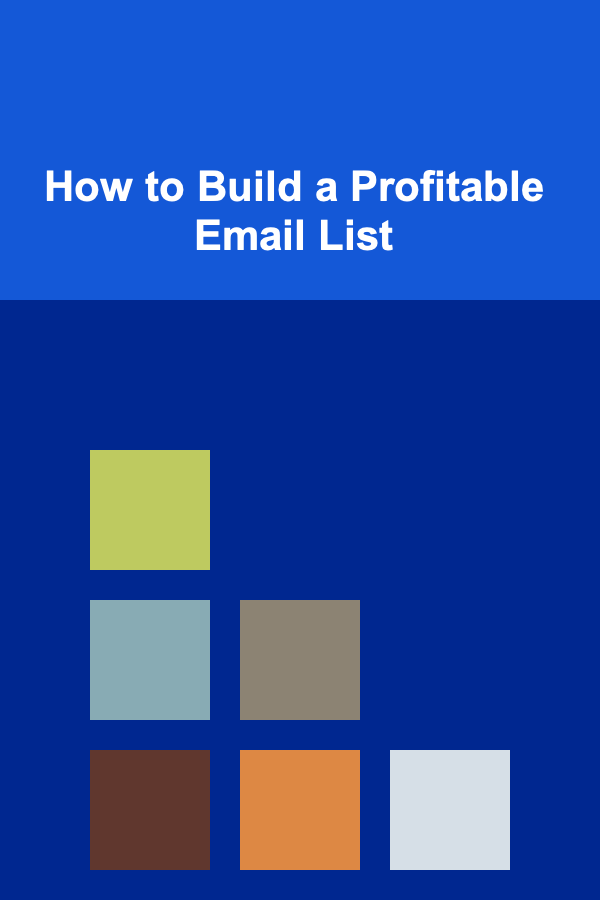
How to Build a Profitable Email List
ebook include PDF & Audio bundle (Micro Guide)
$12.99$8.99
Limited Time Offer! Order within the next:

Building a profitable email list is a crucial strategy for any business, entrepreneur, or content creator aiming to engage an audience and generate revenue. Email marketing continues to outperform other digital marketing tactics, providing the highest return on investment (ROI) when done correctly. Whether you're looking to promote products, share valuable content, or nurture relationships with your audience, having an email list can significantly amplify your efforts.
In this article, we'll explore the step-by-step process of building an email list that not only grows but also becomes a valuable asset to your business. From understanding the basics of email list building to advanced strategies for optimization and monetization, this guide will provide you with the tools and knowledge to successfully grow and profit from your email list.
Why Building an Email List is Essential
Before diving into the tactics of building an email list, it's important to understand why this is a powerful strategy.
Direct and Personal Communication
Email allows you to communicate directly with your audience in a personalized way. Unlike social media, where algorithms determine who sees your content, emails land directly in the inbox of your subscribers, making them more likely to read and engage with your message. With the right approach, email can feel more personal and intimate than other forms of communication, leading to higher engagement rates.
Control Over Your Audience
When you own an email list, you have control over your audience and how you communicate with them. You don't have to rely on third-party platforms, which can change algorithms, restrict reach, or shut down entirely. Email allows you to build a sustainable audience that you can engage with on your terms.
High Return on Investment (ROI)
According to the Data & Marketing Association (DMA), email marketing boasts an average ROI of 42:1, meaning for every dollar spent, you could expect to earn $42 in return. This makes email marketing one of the most cost-effective and profitable marketing channels available.
Nurturing Relationships
An email list allows you to nurture relationships with your subscribers over time. With strategic email campaigns, you can build trust, offer value, and guide subscribers through your sales funnel, ultimately converting them into loyal customers.
Step 1: Understand Your Audience
The foundation of any successful email list is a deep understanding of your target audience. Before you begin collecting email addresses, you need to know who your ideal subscribers are, what they care about, and how they consume content.
Defining Your Ideal Subscriber
To build an email list that converts, you must first define your ideal subscriber. Create a detailed buyer persona that includes information such as:
- Demographics: Age, gender, location, income level, etc.
- Psychographics: Interests, values, lifestyle, challenges, and pain points.
- Goals: What are they hoping to achieve? What problems are they trying to solve?
- Content Preferences: How do they consume content (videos, blogs, podcasts, etc.)?
Understanding your audience will help you create content and offers that resonate with them, making it more likely they will subscribe to your email list.
Segmenting Your Audience
Once you've defined your audience, the next step is to segment them into different groups. Not all subscribers will be interested in the same types of content or offers. By segmenting your list based on factors like demographics, behavior, and interests, you can send more targeted and relevant emails.
For example, if you sell digital marketing tools, you could segment your audience into groups like:
- New subscribers
- Existing customers
- Potential customers who have shown interest but haven't purchased
- Highly engaged users
By sending tailored messages to each group, you can improve engagement rates and conversion rates, ultimately leading to higher profits.
Step 2: Choose the Right Email Marketing Platform
An email marketing platform is essential for building, managing, and optimizing your email list. These platforms allow you to collect email addresses, create email campaigns, and track performance metrics. Some popular email marketing platforms include:
- Mailchimp: A user-friendly platform that offers a free plan for beginners.
- ConvertKit: Ideal for content creators and bloggers, with robust automation tools.
- ActiveCampaign: Known for advanced automation and segmentation features.
- GetResponse: A versatile platform with landing page creation and webinar integration.
When choosing an email marketing platform, consider the following:
- Ease of use: Is the platform user-friendly and intuitive?
- Automation features: Does the platform support automated workflows, sequences, and triggers?
- Integration capabilities: Can the platform integrate with your website, CRM, and other tools?
- Analytics: Does the platform provide insights into open rates, click-through rates, and other important metrics?
Setting Up Your Email Marketing Platform
Once you've chosen your platform, it's time to set it up. Most platforms offer a step-by-step guide to help you get started. You'll need to:
- Create an account: Sign up and set up your profile.
- Design your email template: Most platforms offer drag-and-drop builders that make it easy to design professional-looking emails.
- Create sign-up forms: Design and embed sign-up forms on your website or landing pages to capture email addresses.
- Set up automations: Create automated workflows to nurture leads and engage with your subscribers.
Step 3: Create an Irresistible Lead Magnet
One of the best ways to build an email list is by offering something of value in exchange for email addresses. This is known as a "lead magnet." A lead magnet is a free resource, tool, or piece of content that solves a problem or provides value to your audience.
Types of Lead Magnets
There are many different types of lead magnets you can offer, including:
- Ebooks or Guides: In-depth resources that provide valuable information.
- Checklists or Templates: Simple tools that make it easier for your audience to implement your advice.
- Webinars or Video Trainings: Live or pre-recorded presentations that offer education and value.
- Free Trials or Samples: If you offer a product or service, providing a free trial or sample is an effective way to attract subscribers.
- Quizzes or Assessments: Interactive content that helps your audience identify their needs or challenges.
How to Create an Irresistible Lead Magnet
To create a lead magnet that attracts high-quality subscribers, follow these tips:
- Solve a Specific Problem: Your lead magnet should address a specific pain point or need that your audience has. The more targeted and relevant the lead magnet, the more likely people will be to sign up.
- Keep It High-Quality: Your lead magnet should be well-designed, informative, and professionally presented. A high-quality lead magnet builds trust and sets the tone for your future communications.
- Make It Easy to Consume: Your lead magnet should be easy to access and consume. If it's an ebook or guide, make sure it's easy to read. If it's a video, keep it concise and engaging.
Step 4: Use Effective Sign-Up Forms and Landing Pages
Once you've created your lead magnet, you need a place to collect email addresses. This is where your sign-up forms and landing pages come in.
Designing a High-Converting Sign-Up Form
Your sign-up form is the gateway to your email list. It needs to be easy to find and compelling enough for visitors to provide their email address. Here are some tips to optimize your sign-up form:
- Keep It Simple: Ask for just the essentials (e.g., name and email address). The fewer fields you ask for, the higher your conversion rates.
- Use Clear Call-to-Actions (CTAs): Your CTA should be direct and action-oriented. Instead of "Submit," use something like "Get My Free Guide" or "Join the Community."
- Offer an Incentive: Let visitors know exactly what they'll get in return for signing up (e.g., "Get my free ebook on digital marketing strategies").
Creating a High-Converting Landing Page
A landing page is a dedicated page where visitors can learn about your lead magnet and sign up for your email list. Here's how to create a high-converting landing page:
- Clear and Compelling Headline: Your headline should clearly convey the value of your offer.
- Use Testimonials or Social Proof: If applicable, include testimonials or social proof to build trust and credibility.
- Focus on the Offer: Keep the page focused on your lead magnet and avoid distractions.
- Limit Navigation: Remove links or buttons that might distract visitors from signing up.
Step 5: Drive Traffic to Your Lead Magnet
Once your email capture forms and landing pages are set up, you need to drive traffic to them. There are several ways to attract visitors to your lead magnets:
- Content Marketing: Write blog posts, create videos, or record podcasts that drive traffic to your landing pages.
- Social Media: Use your social media profiles to promote your lead magnet and encourage followers to sign up.
- Paid Ads: Run targeted paid ads on platforms like Facebook, Instagram, or Google to drive traffic to your landing pages.
- Guest Blogging: Write guest posts for other blogs in your niche and include a link to your lead magnet.
- SEO: Optimize your website for search engines to attract organic traffic to your landing pages.
Step 6: Nurture and Engage Your Email List
Once you've started building your email list, it's important to nurture and engage your subscribers. An email list that isn't nurtured will quickly lose its value. Here's how you can keep your subscribers engaged:
- Welcome Emails: Send a warm welcome email when someone first subscribes to your list. This sets the tone for your relationship and makes the subscriber feel valued.
- Consistent and Valuable Content: Regularly send valuable content, whether it's educational, inspirational, or promotional. The key is to consistently provide value.
- Segmentation and Personalization: Use segmentation to send more relevant and personalized emails to different groups of subscribers.
- Automated Email Sequences: Set up automated email sequences that nurture leads, promote products, or deliver educational content.
Step 7: Monetize Your Email List
Once you've built a healthy, engaged email list, you can start monetizing it. There are several ways to generate revenue from your email list:
- Affiliate Marketing: Promote third-party products or services and earn a commission for each sale made through your referral link.
- Selling Your Own Products or Services: If you have products or services to sell, your email list is a perfect channel to promote them.
- Sponsored Emails: If your email list is large and engaged, you can sell space in your emails to other businesses for sponsored content.
Conclusion
Building a profitable email list is not an overnight process. It requires careful planning, execution, and ongoing optimization. By understanding your audience, offering valuable lead magnets, and nurturing relationships with your subscribers, you can create an email list that drives significant revenue for your business. Email marketing remains one of the most effective strategies for building long-term success, and with the right approach, you can leverage it to generate profits and grow your business.

How to Make Money Offering Marketing Consulting Services on a Part-Time Basis
Read More
How to Make Your Home Smell Like the Holidays with Scented Decor
Read More
How to Rent Out Your Spare Space for Profit
Read More
How to Travel with a Backpack on a Budget
Read More
How to Cook Japanese Home Cooking Favorites
Read More
How to Use a Book Reading Planner for Genre Exploration
Read MoreOther Products

How to Make Money Offering Marketing Consulting Services on a Part-Time Basis
Read More
How to Make Your Home Smell Like the Holidays with Scented Decor
Read More
How to Rent Out Your Spare Space for Profit
Read More
How to Travel with a Backpack on a Budget
Read More
How to Cook Japanese Home Cooking Favorites
Read More